How to build an effective executive scorecard for your busy CEO

In 2010, CEOs had three key priorities:
- Sets the overall vision and strategy of the company and communicates it to all stakeholders.
- Recruits, hires, and keeps the best talent for the company.
- Makes sure there is always enough cash in the bank.
If you’ve tried to speak to your CEO today, you might find them difficult to reach as they’re always at meetings or out of the office representing the company to external stakeholders.
You’re not alone. A 2021 study on how CEOs spent their time found CEOs’ calendars overbooked during working hours, with 75% of their time allocated in advance.
Hence, if you’re reporting to your CEO or senior managers, it’s important to make it easy for them to review your reports while providing the necessary answers. Here’s where an executive scorecard comes in handy as a performance measure.
- What are executive scorecards?
- Four reasons executive scorecards are essential for business success
- How to build an effective executive scorecard with DashThis
- 3 executive scorecard examples and templates
- Automate your reporting
What are executive scorecards?
Consider executive scorecards as a one-pager presenting key performance indicators (KPIs) and metrics relevant to an organization's strategic objectives.
It’s a single source of truth for your CEO, vice presidents, and executive team to know how they progress towards their objectives across business units or which business process to improve.
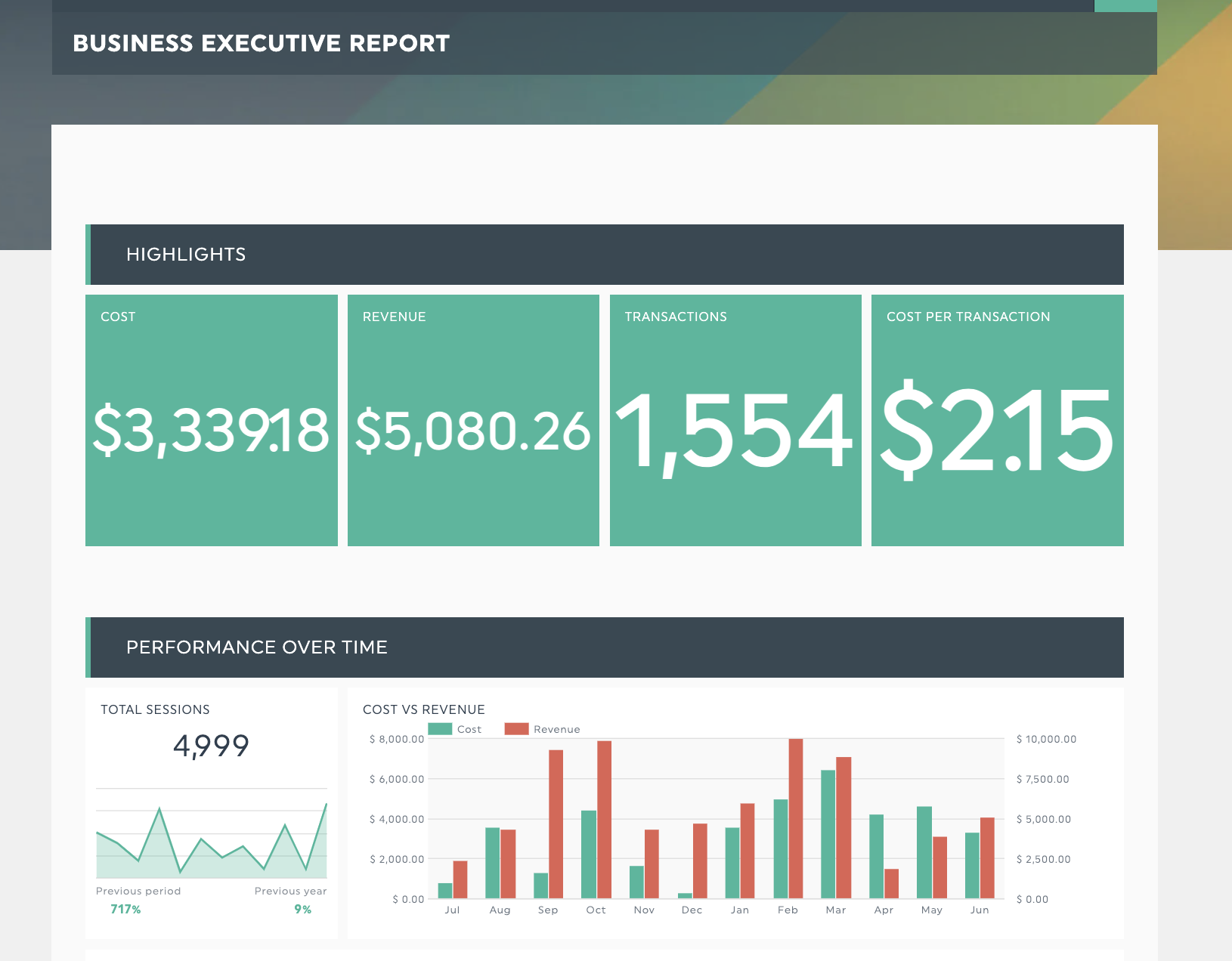
A good executive scorecard example has these three features:
- Focused
Every metric included in an executive scorecard should relate to a key performance target. For example, if one of your business objectives is to improve customer satisfaction, measure KPIs like customer lifetime value, client retention rate, and customer churn rate.
- Concise
Executive scorecards only include the most important KPIs (10-15 are a good limit to keep to).
- Actionable
Measuring numbers is just the first step. Incorporating analysis and recommendations based on the data in your scorecard turns your data into useful, actionable information for your executive to decide from.
Four reasons executive scorecards are essential for business success
Evaluate performance at a glance
Fragmented data streams are a real challenge for marketing departments today. According to Salesforce’s 2022 Marketing Intelligence Report, 98% of marketers know it’s important to have a single view of all cross-channel marketing, but 71% still evaluate the performance of cross-channel marketing in silos.
Data-driven marketing is a competitive advantage, and executive scorecards help marketers get the marketing data they need in one place to assess the effectiveness of their marketing campaigns, initiatives, and overall strategies. Having the data you need in one place with integrations helps you communicate to your senior team if progress is on track and whether you’re using budgets effectively.
Keeps day-to-day activities aligned with business objectives
Ever spent hours designing a client campaign to build brand awareness, only for it to be rejected, as you didn’t understand that the company wanted to grow its sales in a new product segment?
With an executive scorecard, you’ll make sure these situations hardly happen. You’ll get a clear link between organizational objectives and marketing’s impact from the customer perspective to help your executive management and team with strategic planning.
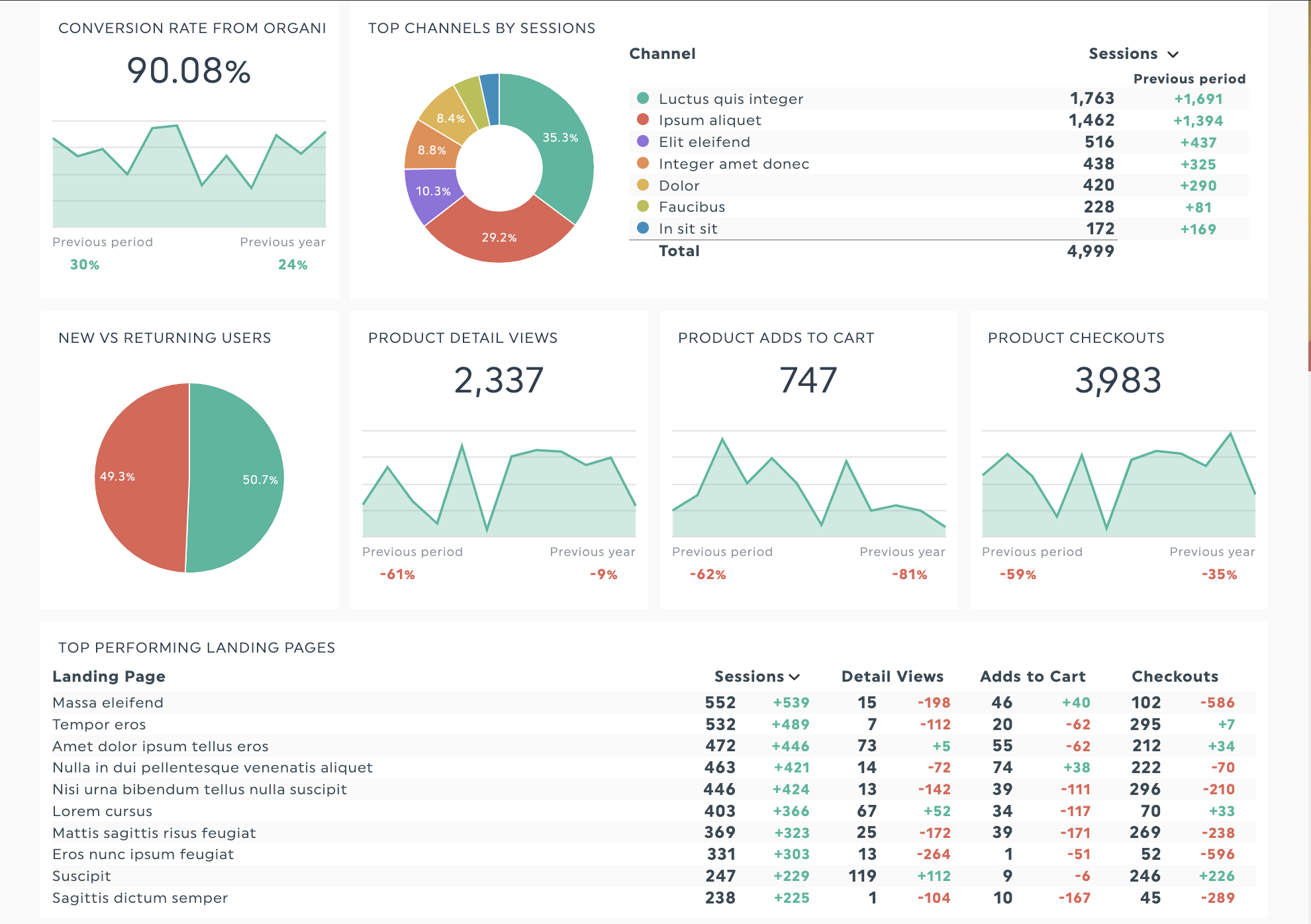
Grab this e-commerce scorecard with your own data!
For example, if one of your business goals is to boost e-commerce sales this year, this e-commerce scorecard summarizes your checkouts, sales, add-to-carts, and top-performing landing pages; helping your head of sales or marketing to understand your customer’s behavior flow and identify what to improve in the customer journey.
Facilitates communication and collaboration across the organization
Studies from McKinsey and IDC show employees can spend 1.8 to 2.5 hours per week searching for information. That’s 30% of a standard workday wasted.
With scorecards, you’ll help save time wasted looking for information. These useful tools simplify how you communicate your monthly results, what you did to get them, and recommendations for the next steps to share with your senior management team, external partnerships, or internal teams.
Speeds up decision-making
Senior executives are often involved in discussions and meetings on diverse topics. For example, Nissan Joseph, CEO of Metro Brands Limited, one of India's largest footwear brands, can participate in 6-7 intense meetings with investors, employee stock options, land investments, and team meetings in 3 hours.
This constant context-switching means CEOs rarely have time to dive into the details and need information quickly. Executive scorecards provide a consolidated view of relevant metrics, allowing your senior manager or CEO to understand business performance, identify areas of concern and evaluate your recommendation and next steps.
But how do you put an executive scorecard together? Reporting tools like DashThis can help here. We’ll show you how.
How to build an effective executive scorecard with DashThis
1. Know the objective and audience of your scorecard
Knowing what you’re trying to achieve before putting together your scorecard is useful. You may not put all this information in your scorecard, but thinking about the aims of your scorecard will help with structuring your thoughts and selecting the right metrics to capture your busy executive’s attention.
Questions to ask yourself here and example answers:
- What do the people reviewing your scorecard care about?
You’re creating an executive scorecard for your CFO and CEO. They aren’t experienced in marketing but care about numbers and budgets. They want to know financial metrics like marketing’s return on investment to benchmark future business cash flow.
- What business objective are you reporting on?
Growing profitability by improving the health of your sales pipeline. You're looking to increase your investment in paid social media ads after your paid social media ads campaign delivers outstanding results.
- Why is it important to read your scorecard?
Do you have a recommendation, a proposed outcome, and an action plan? Example: In the next six months, we can double our revenue by investing 30% more in Facebook and Instagram ads targeting our top-selling product range.
2. Keep your data points relevant
One common mistake people make when presenting a scorecard to their senior management team to review is focusing on how much work they’ve done and cramming every data point into their scorecard.
But this approach overwhelms your busy executive, making their scorecard ineffective.
Instead, our accounts team shares this tip.
When selecting a metric, ask yourself, “Is this data relevant for my client? Are they going to understand this number easily?” If the data is crucial but complicated, add explanations.
So if you’re sending an executive scorecard and building a case for increased investment into paid social media ads, you might report on these scorecard metrics:
- Total conversions/revenue generated against other marketing channels
- Cost per conversion with paid ads
- Average deal value of leads that came via paid ads vs other marketing channels
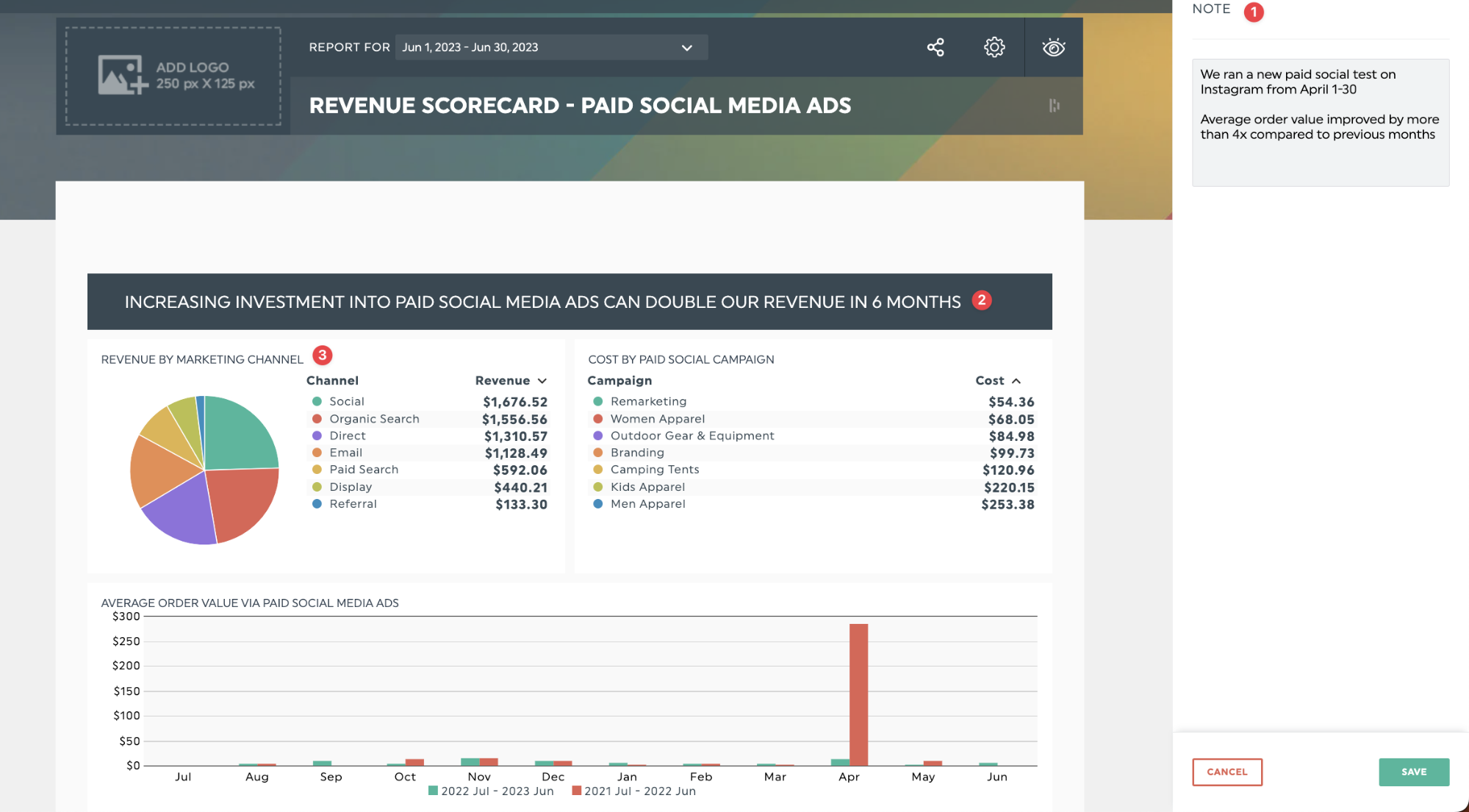
An executive scorecard built in DashThis
- Notes and comments for context
- Outcome-focused statement upfront
- Associated metrics for details and key points
Here’s how to create your executive scorecard with DashThis in 4 easy steps:
- Sign up for your 15-day free trial of DashThis
- Connect your favorite marketing tools like Google Ads or Instagram Ads
- Select your metrics from DashThis’ preset widgets (or get started with our templates below)
- Drag and drop the metrics you need.
3. Send the scorecard regularly so it's easy to review
Don’t forget to send your scorecard to your CEO or senior team. DashThis has a variety of automated report-sharing options to help you. Choose the best option for your needs - automate an email dispatch, export your scorecard as a PDF, or send your dashboard URL via chat!
If you’re still spending hours in Excel doing your executive reports and executive scorecards, DashThis is an easy way to up your game while making the reporting process less stressful.
3 executive scorecard examples and templates
Executive scorecard template
Make your CEO’s life easier by presenting them with clear, concise scorecards with the information they need for decisions.
Our executive scorecard template keeps essential sales and marketing contributions to revenue information on top. Hence, they know marketing performance at a glance, reserving details to review below the fold.

Get this executive report template with your own data!
GA4 report template
Does your CEO want to know how your new website or app’s performance compares to the old one? Use our GA4 template to get your essential web analytics metrics into one page quickly. With all your data in one place, it’s easy to make comparisons across time and look out for patterns and trends in the data.
Tip: if your senior team isn’t familiar with GA4 definitions, define the terms in a note and comment next to a widget for them to understand what you mean quickly.
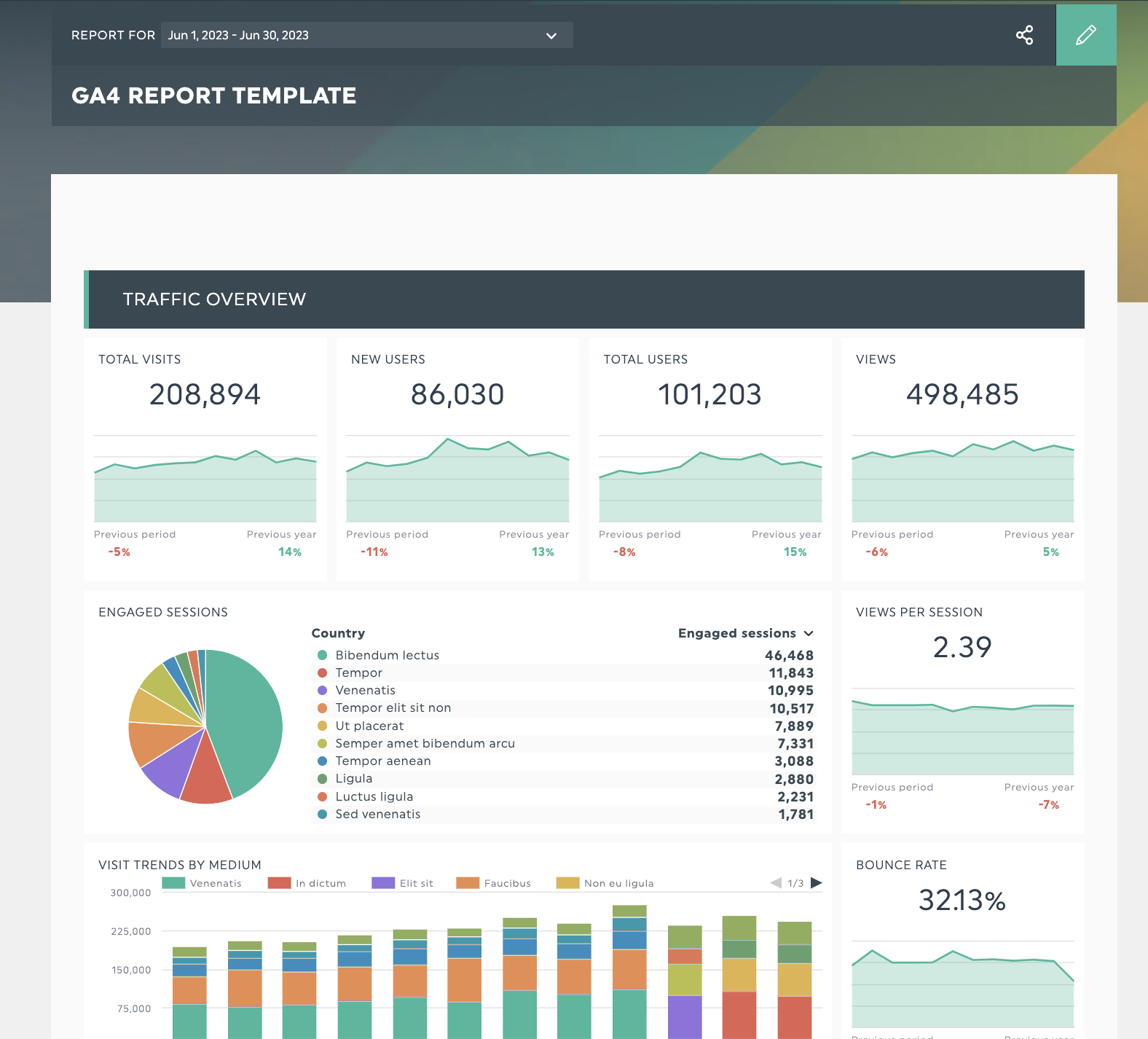
Get this GA4 report template with your own data!
Advertising campaign report template
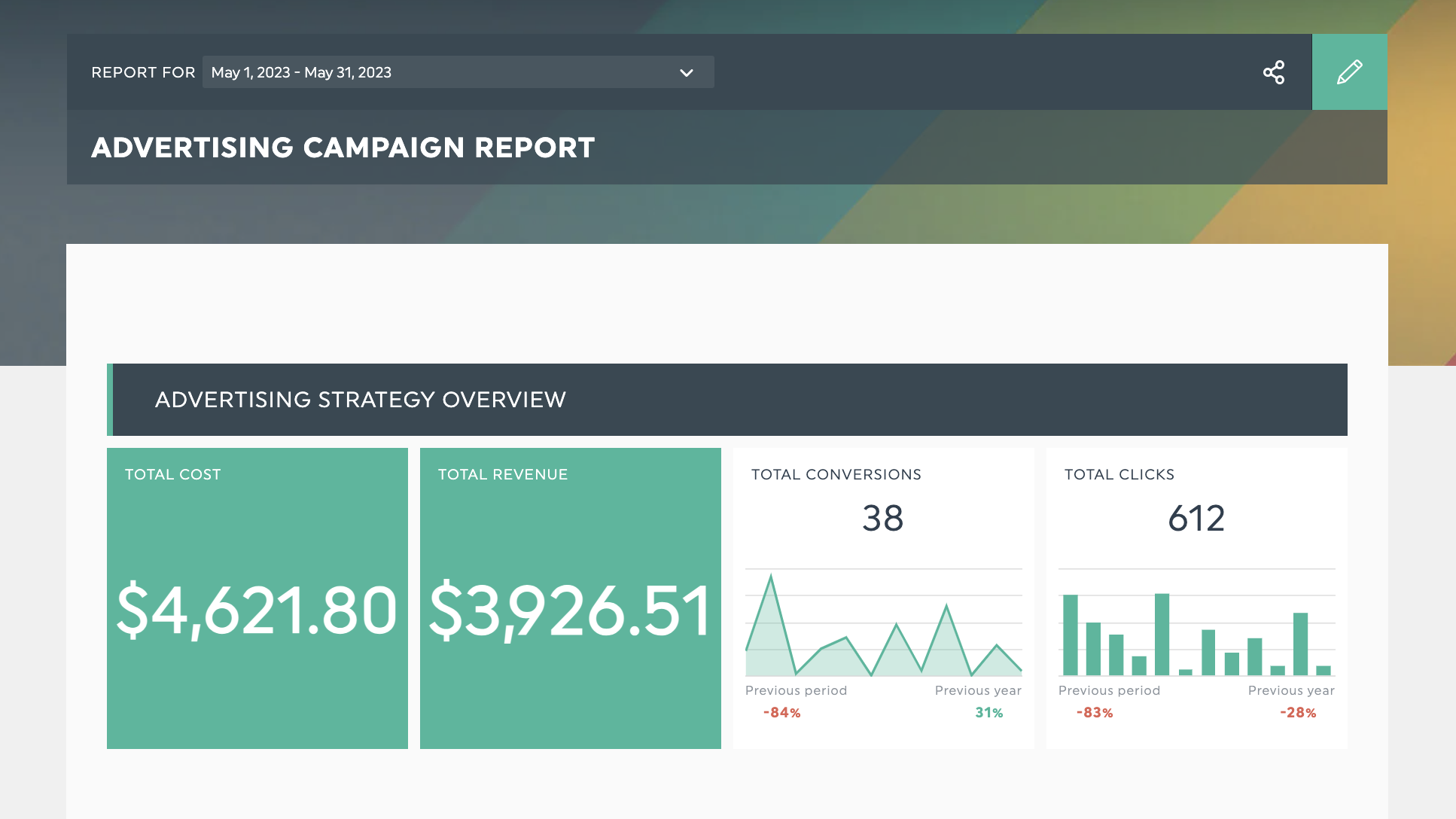
Get this advertising campaign reporting template with your own data!
There are many moving parts in marketing, and getting all your data in one place, whether it’s email campaigns, Facebook ads, or social media marketing initiatives is challenging.
This advertising campaign report starts with an overview of critical revenue and cost metrics while allowing your executive to drill down into specific channels, campaigns, and ads in real-time for more information. Connect your marketing tools to import your data to get started with your marketing scorecard.
Automate your reporting with DashThis
How much time do you spend on your monthly executive scorecards? That’s time and wages you can put to better use while keeping your clients and internal stakeholders happy about the quality of your reports and showing how much value you’re providing through your work.
Invest in a better reporting experience today with DashThis without tearing your hair out. Sign up for your free 15-day trial of DashThis today.
Track your most crucial executive KPIs
Read More
Don’t miss out!
Automate your reports!
Bring all your marketing data into one automated report.
Try dashthis for free

